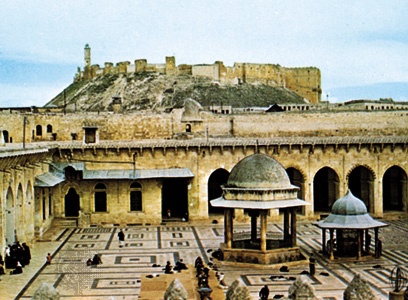Aleppo
Syria
Arabic Ḥalab, Turkish Halep
 principal city of northern Syria. It is situated in the northwestern part of the country, about 30 miles (50 km) south of the Turkish border. Aleppo is located at the crossroads of great commercial routes and lies some 60 miles (100 km) from both the Mediterranean Sea (west) and the Euphrates River (east).
principal city of northern Syria. It is situated in the northwestern part of the country, about 30 miles (50 km) south of the Turkish border. Aleppo is located at the crossroads of great commercial routes and lies some 60 miles (100 km) from both the Mediterranean Sea (west) and the Euphrates River (east).The city's Arabic name, Ḥalab, is of ancient Semitic origin and is first mentioned in texts at the end of the 3rd millennium BC. In the 18th century BC Ḥalab was the capital of the Amorite kingdom of Yamkhad, and it subsequently came under Hittite, Egyptian (Egypt, ancient), Mitannian (Mitanni), and again Hittite rule during the 17th to 14th centuries. In succeeding centuries it achieved some independence as a Hittite principality. It was conquered by the Assyrians in the 8th century BC, was controlled by the Achaemenian Persians from the 6th to the 4th century BC, and then fell into the hands of the Seleucids, who rebuilt it and renamed it Beroea. It became a first-ranking city of the Hellenistic period and a great commercial entrepôt between the Mediterranean region and the lands farther east. The city was absorbed into the Roman province of Syria in the 1st century BC. It prospered under Byzantine rule but was pillaged and burned by the Persian Sāsānian king Khosrow I in AD 540. In 637 the city was conquered by the Arabs, under whom it reverted to its old name, Ḥalab.
In the 10th century the Ḥamdānid Dynasty established itself in Aleppo as an independent principality, and the city had a brilliant cultural life under their rule. In the 12th century Aleppo became a centre of Muslim resistance to the Crusaders, who besieged it unsuccessfully in 1124–25. In 1260 Aleppo was taken by the Mongols, who massacred its inhabitants. After an interval of several centuries under the Mamlūks, the city was incorporated in 1516 into the Ottoman Empire, under which it underwent a remarkable commercial revival, becoming the principal market in the Levant. Its prosperity continued until the end of the 18th century, and full economic recovery came in 1880 with the arrival of the railroad. In the 20th century the city became an industrial centre rivaling Damascus.
The old section of Aleppo, designated a UNESCO World Heritage site in 1986, is built around a 12th-century-AD citadel that rests on a partly man-made mound dominating the city. The old section has the most famous covered bazaars in the Middle East, which extend for miles through narrow streets. Its many khans (caravan rest houses), mosques, and merchants' houses are built of limestone, with many dating from the 16th and 17th centuries. Another point of interest is the Great, or Zakariyah, Mosque (built AD 715, rebuilt 1258), which is named for Zacharias, the father of John the Baptist. Parts of the city's old stone walls, along with several of their gates, are still intact.
Aleppo's main industries are silk weaving, cotton printing, the manufacture of soaps and dyes, and the preparation of hides, wool, dried fruit, and nuts. Aleppo is also an intellectual centre with Aleppo University (1960), an institute of music, and several madrassas (Muslim theological schools). The city's archaeological museum displays ancient artifacts found in northern Syria at several major archaeological sites.
Aleppo lies along the Istanbul-Baghdad railway and is linked by rail to Damascus and Beirut (Lebanon) as well. It has road connections to Damascus, Latakia, and Antioch (Turkey), along with an airport. It is a market centre for the surrounding agricultural area, which produces wheat, cotton, barley, vegetables, fruit, nuts, and sesame. Pop. (2004 est.) 1,975,200.
- Canfield, Cass
- Cangas de Narcea
- Cange, Charles du Fresne, Seigneur du
- Cangzhou
- Caniapiscau River
- Caniff, Milton
- canine
- canine distemper
- canine parvovirus disease
- canine tooth
- canine viral hepatitis
- Canisius College
- Canisius, Saint Peter
- Semnān
- semolina
- Sempach, Battle of
- Semper, Gottfried
- Sempill, Robert
- Sempill, Sir James
- Semple, Ellen Churchill
- Semyon Ivanov Dezhnyov
- Semyon Konstantinovich Timoshenko
- Semyon Mikhaylovich Budenny
- Semyonov, Nikolay Nikolayevich
- Sena